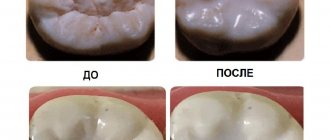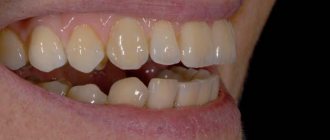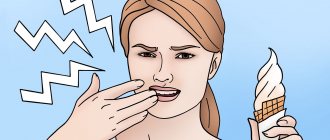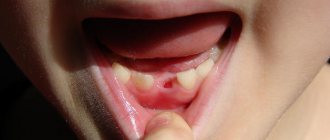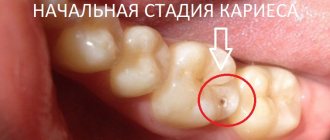The topic of anesthesia in dentistry is one of the most discussed, since its use allows most dental procedures to be performed painlessly for the patient. However, treatment involving serious interventions (treatment of pulpitis, tooth extraction, prosthetics) is significantly complicated if the patient is allergic to anesthesia.
According to experts, allergic reactions, hypersensitivity to the components of the drug occur in 15-20% of patients. Allergies have different causes and manifestations, and accordingly, the solution in each situation must be individual.
Allergy to anesthesia in dentistry: main types
The reaction to anesthesia has 3 different development mechanisms:
- allergic;
- toxic;
- psychogenic.
Allergies directly to an anesthetic drug are extremely rare, difficult to diagnose, and have a cumulative nature. As a rule, the reaction occurs after the 2-5th application of the anesthetic and is manifested by both local and generalized symptoms (urticaria, edema, anaphylactic shock).
Most often, an allergy occurs not to the anesthetic itself, but to the excipients that are present in it or in the packaging (latex, parabens, bisulfites that prevent the oxidation of active ingredients). As a result, the patient experiences a toxic reaction to dental anesthetics and is the most common.
The psychogenic type of allergy is not a problem of somatic origin. It is associated with the patient’s fear of dental procedures and increased anxiety. The most common psychosomatic reaction to local anesthesia is fainting after injection.
Basophil Activation Test (BAT)
In recent decades, BAT has been the classic method for diagnosing allergies. Basophils and mast cells play a central role in immediate allergic reactions. DG Ebo [18] points to the increasing interest of researchers in BAT, in which the activation of these cells is measured by flow cytometry. Currently, the most commonly used basophil activation markers are CD63 and CD203c. Flow-CAST and CAST-ELISA are commercial assays based on basophil activation. CAST-ELISA determines the release of sulfodyleukotrienes activated by basophils by ELISA. The analysis is extremely slow and takes a lot of working time; its use is impractical in busy laboratory conditions.
Flow-CAST uses flow cytometry to identify basophils labeled with anti-IgE-fluorescein isothiocyanate and anti-CD63-PE, markers of activation and degranulation. Modification of Flow-CAST using anti-CD203c instead of anti-CD63 improves the performance of the study [25].
The sensitivity and specificity of BAT in allergy to muscle relaxants are reported to range from 36% to 92% and from 93% to 100%, respectively [26], and for allergy to beta-lactam antibiotics, the sensitivity ranges from 33% to 67% and the specificity from 79% to 100% [27]. The BAT method can be considered very promising for the assessment of both immediate allergic reactions and non-allergic hypersensitivity [28]. There is limited experience with the use of the BAT method for drug allergies to LA. So, N.V. Bychkova studied the reactions of 189 people (average age 37 years) to MA groups of articaine, lidocaine, mepivacaine (1:30 dilution). The least sensitization was detected in patients to drugs of the lidocaine (8%) and mepivacaine (3%) group. Among drugs in the articaine group, the frequency of positive reactions in patients varied from 41% to 18%, depending on the composition of the drug. The author concludes that the use of lidocaine, mepivacaine and articaine, which do not contain preservatives, is preferable for patients [29].
How does an allergy to local anesthesia manifest: symptoms
Symptoms depend on the mechanism of allergy development. With a contact allergy, the patient experiences:
- itching;
- burning;
- development of allergic stomatitis;
- edema.
An allergy to the components of the drug can cause a reaction in the skin, respiratory system, or cardiovascular system. In severe cases of allergies, anaphylactic shock may develop.
Symptoms:
- tingling of the facial skin;
- general weakness;
- the appearance of chest pain.
In the absence of timely medical care, swelling of the respiratory tract begins, heart failure, and convulsions develop.
A toxic reaction differs from an allergy in both its symptoms and the nature of its effect on the body. Anesthetic drugs contain vasoconstrictor components.
How does an allergy to anesthesia manifest itself with increased vascular permeability, direct contact with a needle into a blood vessel when the anesthetic is administered:
- acceleration/deceleration of heartbeat;
- dizziness;
- lethargy;
- decreased visual acuity;
- noise in ears.
Allergy to dental anesthesia: causes
The most common causes of allergies to local anesthetics:
- hypersensitivity to anesthetic drugs;
- vegetative-vascular diseases;
- hereditary factor;
- incorrect dosage calculation;
- intravascular injection;
- psychoneurological disorders.
Hypersensitivity to local anesthetic drugs
In dentistry, multicomponent drugs are used for local anesthesia. The main active ingredient in them, as a rule, does not have side effects in the form of allergies, and complications are associated with excipients in the solution.
If the body is sensitive to individual components of anesthesia drugs, dentistry uses painkillers with the most simplified composition.
How do you know if you are allergic to anesthesia?
For diagnostic purposes, a blood test for allergies to anesthesia is performed (allergy tests). This test is performed as prescribed by an allergist or dentist. The direction indicates the drugs for which the study should be carried out.
Indications for allergy testing:
- there have previously been cases of an allergic reaction to local anesthesia in dentistry;
- the patient is allergic to any drug;
- before dental treatment, if a person has symptoms such as cough, urticaria and itching of the skin, lacrimation for no known reason.
The analysis does not require preliminary preparation or adherence to the “fasting” rule. However, you should not take antihistamines before taking samples. The analysis is not carried out during periods of acute infectious diseases, exacerbation of chronic diseases, at elevated temperatures, during pregnancy and for several weeks after delivery or termination of pregnancy.
Symptoms
Signs of allergies are presented in the following list:
- Changes in taste sensations - when eating food, a bitter, sour or metallic taste appears, which is not characteristic of cooked dishes;
- Burning sensation in the mouth or tongue;
- Excessive salivation or, conversely, complete dry mouth;
- Inflammation of the mucous membrane, tongue and gums: swelling, redness, the appearance of small ulcers and bleeding;
- Electrical discharges in the oral cavity, due to the presence of two or more metal alloys in the filling unit;
- Redness and swelling of the eyelids, nose, lips, cheeks, accompanied by a sore throat.
These are the most common reactions of the body to low-quality filling and orthodontic preparations.
Allergy to anesthesia in children
Recently, there has been a tendency to increase the number of cases of diagnosing various types of allergies in children. When using local anesthesia in children with allergies in dentistry, there is a higher risk of developing an allergic reaction and various complications. Therefore, special attention is paid to the choice of local anesthetic for a child in dentistry.
Let's tell you how we solve this problem at the Amel Smart clinic:
- The clinic employs experienced anesthesiologists who advise and help choose the safest method of pain relief for the child;
- In addition to classical anesthesia, we use computer anesthesia and sedation in pediatric dentistry;
- a note about allergies is placed in the baby’s medical record;
- all clinic staff have been trained and are ready to provide professional emergency assistance at any time;
- Each room is equipped with a kit necessary to provide first aid for anaphylactic shock.
In most cases, dental treatment in pediatric dentistry is carried out without pain relief. But for large problems that require serious intervention, pain relief cannot be avoided. In this case, pediatric anesthesia is used, and during dental procedures, an anesthesiologist is constantly present in the office to monitor the main indicators of the child’s condition.
Dental treatment for allergies to anesthetics
Today, it is possible to choose the optimal method of pain relief in dentistry for each patient. In this case, many factors are taken into account: the complexity of treatment, the tendency to allergies and the presence of hypersensitivity to specific drugs, the general condition of the patient.
In the case of drug allergies, whenever possible, treatment is carried out without pain relief. For serious interventions, the doctor selects the drug for anesthesia, taking into account the patient’s existing contraindications (modern dentistry can offer a large selection of safe anesthetics). Nowadays, it is quite common practice that in dentistry, before treatment, tests are carried out for allergies to anesthesia drugs, which allow you to choose a safe solution for pain relief and eliminate the risk of complications. In rare cases, when it was not possible to select a drug for local anesthesia, dental treatment can be performed under anesthesia.
To avoid a toxic reaction, changing the anesthetic or abandoning local anesthesia is not required. The doctor uses a special needle insertion technique called a "blood test" that prevents the drug from being injected directly into the blood vessel.
In addition, Amel Smart uses hardware anesthesia, which has many advantages:
- performing different types of anesthesia;
- the most accurate dosage of the drug;
- precise determination of the injection site;
- painlessness of the procedure.
For patients with a psychosomatic reaction to anesthesia, injections of the drug are given in a lying position. If the patient is very afraid or experiences severe psychological discomfort from being in the clinic or the upcoming manipulations, he is offered treatment with sedation (medicated sleep).
Desensitization
This is the name of the procedure that helps get rid of allergy symptoms if it is impossible to stop the drug. This happens with life-saving essential drugs.
The essence of the method is to gradually increase the dose from the minimum to the required for treatment. At the same time, reactions similar to those observed during allergy vaccination occur in the body. Desensitization techniques exist and are used for insulin, antibiotics and aspirin.
Effective diagnosis and treatment of drug allergies in the multifunctional CELT clinic. New treatment methods, qualified allergists, modern equipment - with CELT specialists it is easy to maintain your health.
Make an appointment through the application or by calling +7 +7 We work every day:
- Monday—Friday: 8.00—20.00
- Saturday: 8.00–18.00
- Sunday is a day off
The nearest metro and MCC stations to the clinic:
- Highway of Enthusiasts or Perovo
- Partisan
- Enthusiast Highway
Driving directions
First aid for allergies to local anesthesia
If a patient experiences an allergy attack due to anesthesia, the dentist has an emergency kit in his office for such an event. It includes antihistamines, antishock drugs, antispasmodics, adrenaline, syringes, alcohol, venous catheter and tourniquet, gauze, cotton wool, saline solution. Every dental specialist has the skills to provide first aid to patients before the ambulance arrives.
Treatment of allergies to anesthetic in dentistry includes standard measures used in the treatment of allergic diseases:
- 1
Elimination of the provoking factor. - 2
Antihistamine therapy.
- 3
Preventive therapy.
Prevention of allergic reactions: recommendations from Amel Smart specialists
To avoid unwanted reactions and complications from the use of anesthetic in dentistry, you must follow a number of rules:
- if you have an allergy to painkillers or other types of allergies, you must inform your doctor about it before starting treatment;
- information about allergies must be in the patient’s medical record;
- To diagnose intolerance to anesthetics, the dentist prescribes an anesthesia allergy test for the patient;
- Having information about the type of allergy, the doctor does not use drugs containing the allergen in the treatment of the patient;
- if premedication is necessary for patients with allergies, the anesthetic drug is combined with antihistamines, and in some cases with hormonal anti-allergy drugs.
If you suspect an allergy, it is advisable to consult an allergist before going to the dentist. Having information about intolerance to certain components, experienced doctors at the Amel Smart dental clinic will select the safest solution to the patient’s problem.
Our doctors
Shundeva Oksana Veniaminovna
Allergist, doctor of the highest category
Experience 39 years
Make an appointment
Orlova Tatyana Vladimirovna
Doctor - allergist-immunologist, pulmonologist, doctor of the highest category
Experience 38 years
Make an appointment

